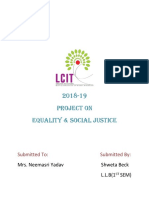KIIT SCHOOL OF LAW, KIIT DEEMED TO BE UNIVERSITY
BHUBANESWAR
TOPIC- Legislative Strategies for promoting social change: a study in India
SUBMITTED TO:
PROF. ARPITA MITRA
SUBMITTED BY
MANNAT GUPTA
2183178
� ABSTRACT
The legislative strategies should be guided by the principles of justice, fairness, and the public interest, and should
aim to promote the welfare and development of the country and its people. The primary objective of legislative
strategies is to draft and pass laws that address various issues faced in India, its people, and its institutions. The
research’s aim is to prove how these legislative strategies have ensured social justice by addressing issues of
inequality, discrimination, and social exclusion. Moreover, on protecting human rights, including the rights of
minorities, women, children, and other vulnerable sections of society.
KEYWORDS
Legislative, social change, justice, public interest, implementation.
INTRODUCTION
The legal system and society have a strong relationship. Law commands nature to engage with civic life, and as
economic, scientific, and technological advancement develops, so does this requirement. Law is subject to social
change and is crucial to addressing social needs. As a result, there is an amendment to the constitution provision
that states that laws that violate the constitution, the public interest, or fundamental rights must be declared invalid.
It is the judiciary's duty to carry out this provision. Law plays a crucial indirect influence in social transformation
through shaping factors that have a direct impact on society. For instance, a law establishing a compulsory
educational system. On the other hand, law interacts with basic social institutions in many circumstances in an
indirect manner, implying a direct relationship between law and social change. For example, a law prohibiting
polygamy. Social change involves an alteration in society's economic structure, values, and beliefs, in addition to
its economic, political, and social factors.
Legislative strategies have played a crucial role in social control in India. The Indian Constitution provides a
framework for the protection of fundamental rights and social justice. The legislature has passed various laws to
address social issues and promote social welfare.
For example, the Scheduled Castes and Scheduled Tribes (Prevention of Atrocities) Act, 1989, is a legislative
strategy aimed at preventing atrocities against Dalits and Adivasis in India. The act provides for stringent
punishment for offences against members of these communities and has been instrumental in protecting their
rights. Similarly, the Protection of Women from Domestic Violence Act, 2005, is a legislative strategy aimed at
addressing the issue of domestic violence against women. The act provides for the protection of women from
physical, emotional, sexual, and economic abuse by their spouses or partners. The act has been effective in
increasing awareness about domestic violence and in providing legal protection to women.
OBJECTIVES
1. Eradication of traditional malpractices and social evils such as child marriage, triple talaq, dowry, untouchability,
female infanticide, etc.
2. Provisions for Social security.
3. Safeguard the rights of weaker section of society.
4. To Strengthen democracy and protect human rights.
CONCEPTUALIZATION
The Protection of Civil Rights Act, 1955: This law was enacted to provide for the enforcement of civil rights of
certain disadvantaged communities, including Dalits (formerly known as "untouchables") and other oppressed
groups.
The Scheduled Castes and Scheduled Tribes (Prevention of Atrocities) Act, 1989: This law aims to prevent
atrocities against members of scheduled castes and tribes and provides for strict punishment for offenses
committed against them.
The Right to Education Act, 2009: This law provides for free and compulsory education for all children aged 6-14
years, with the aim of ensuring universal access to education and reducing disparities in educational opportunities.
The Protection of Women from Domestic Violence Act, 2005: This law aims to protect women from domestic
violence and provides for a range of remedies, including restraining orders, monetary relief, and access to
alternative accommodation.
The Transgender Persons (Protection of Rights) Act, 2019: This law seeks to protect the rights of transgender
persons and prohibits discrimination against them in education, employment, healthcare, and other areas.
These laws, among others, have been enacted to promote social change and address the historical marginalization
and discrimination faced by certain communities in India. While the implementation and effectiveness of these
laws are subject to debate, they represent important steps towards achieving a more equitable and just society.
The Juvenile Justice (Care and Protection of Children) Act, 2015: This act provides for the care, protection, and
rehabilitation of children in need of care and protection, as well as children in conflict with the law.
The Protection of Children from Sexual Offences Act, 2012: This act provides for the protection of children from
sexual offenses, including sexual abuse, exploitation, and harassment. It provides for stringent punishment for
offenders and seeks to create a child-friendly system for the trial of such offenses.
The Mental Healthcare Act, 2017: This act provides for the rights of persons with mental illness and the provision
of mental healthcare services. It also decriminalizes suicide and provides for mental healthcare services to be
provided in a humane, non-discriminatory, and affordable manner.
�FINDINGS
Impact of public awareness:
Awareness in regards to legislative strategies taken in order to provide social change in India can vary depending
on the specific issue or topic being addressed by the legislation. However, in general, there is growing awareness
among the Indian public and civil society organizations about the importance of using legislative strategies to
address social issues and promote positive change. There have been several high-profile legislative initiatives in
recent years aimed at promoting social change in India, such as the Right to Education Act, the Protection of
Women from Domestic Violence Act, and the Juvenile Justice Act. These initiatives have helped to raise public
awareness about the role that legislation can play in addressing social issues and promoting social change.
In addition to high-profile legislative initiatives, there are also a number of civil society organizations and
advocacy groups working to promote legislative strategies aimed at promoting social change in India. These
groups work to build public awareness and support for legislative initiatives, and often play a key role in
advocating for the passage of such legislation. Overall, while there is still work to be done to ensure that legislative
strategies are effectively used to promote social change in India, there is growing awareness of the importance of
such strategies and the potential impact they can have on Indian society.
Role of enforcement mechanisms:
Effective enforcement mechanisms help to ensure that laws and policies are implemented as intended, and that the
desired outcomes are achieved. For example,
Protection of Women from Domestic Violence Act (PWDVA): The PWDVA provides for the establishment of
Protection Officers who are responsible for ensuring compliance with the provisions of the Act. Protection
Officers have the power to issue protection orders, and can take action against violators of the Act.
Right to Education Act (RTE): The RTE Act provides for the establishment of State Commissions for Protection
of Child Rights, which are responsible for ensuring compliance with the provisions of the Act. The Commissions
have the power to investigate complaints of violations of the Act, and can take action against violators.
Juvenile Justice Act (JJA): The JJA provides for the establishment of Juvenile Justice Boards, which are
responsible for handling cases involving children in conflict with the law. The Boards have the power to impose
fines and penalties on offenders, as well as to order rehabilitation and counselling services
By establishing specialized courts, commissions, and boards, and empowering them to take action against violators
of the law, authorities can ensure that legislative strategies aimed at promoting social change are effectively
implemented and enforced.
LITERATURE REVIEW
Legislative strategies for promoting social change can be effective in achieving policy goals: Studies have shown
that legislative strategies, such as passing new laws or amending existing ones, can be effective in achieving policy
goals related to social change.
For example, laws related to gender equality, anti-discrimination, and human rights have been found to have a
positive impact on promoting social change (Banaszak-Holl et al., 2018).
Advocacy coalitions can play an important role in promoting legislative change: Advocacy coalitions, which are
alliances between groups with shared interests and goals, have been found to be effective in promoting legislative
change. These coalitions can bring together diverse stakeholders and facilitate collective action to achieve social
change goals (Sabatier & Weible, 2007).
Legislative strategies should be tailored to the specific context: Research has shown that the success of legislative
strategies for promoting social change is influenced by the specific context in which they are implemented. For
example, the political climate, the level of public support, and the institutional context can all affect the success of
legislative strategies (O'Brien & Pennington, 2019).
Evaluation and monitoring are important for assessing the effectiveness of legislative strategies: Finally, research
has emphasized the importance of evaluation and monitoring for assessing the effectiveness of legislative
strategies for promoting social change. By tracking progress and measuring outcomes, policymakers can make
informed decisions about how to modify or adapt legislative strategies over time (Bovens et al., 2014).
Overall, the literature suggests that legislative strategies can be an effective tool for promoting social change, but
that success depends on factors such as the specific context, stakeholder engagement, and ongoing monitoring and
evaluation.
METHODOLOGY
Qualitative research with secondary data.
� RECOMMENDATIONS AND SUGGESTIONS
By addressing key challenges related to gender inequality, human rights, corruption, environmental challenges,
inclusive growth, and marginalized communities, legislative strategies could help to promote greater social justice
and development for all.
i. Addressing gender inequality: India faces significant challenges related to gender inequality. Legislative strategies
could be designed to promote equal opportunities for women and girls, including measures to address gender-based
violence, increase access to education and employment, and promote women's political participation.
ii. Promoting human rights: India has made significant progress in promoting human rights, but challenges remain,
particularly in relation to the rights of marginalized communities. Legislative strategies could be designed to
promote and protect human rights, including measures to address discrimination, promote access to justice, and
protect vulnerable groups.
iii. Tackling corruption: Corruption remains a significant challenge in India, with negative impacts on economic
growth and social development. Legislative strategies could be designed to promote greater transparency and
accountability, including measures to increase public access to information and strengthen anti-corruption
institutions.
iv. Empowering marginalized communities: India has a large number of marginalized communities, including Dalits,
adivasis, and other vulnerable groups. Legislative strategies could be designed to empower these communities,
including measures to promote greater political representation, increase access to education and employment, and
strengthen social protections.
CONCLUSION
The researcher concludes that social problems are interconnected rather than isolated and law is a mirror to know
how people are related to one another. Effective implementation of law as an instrument or device of social change
should work in tandem with social and cultural life of people of India.
Transformation of social system according to the need of the times and in accordance with the modes and mores of
the people is a matter of necessity. A striking balance between instrumentality of law and folkways and mores of
the people would really pave way for real justice in action. Laws are often created in response to changes in
society, and laws themselves can also bring about social change. On one hand, social change can influence the
creation and evolution of laws. As society evolves and values change, laws may need to be revised or created to
reflect these changes. When laws are enacted or enforced, they can shape people's behaviour and attitudes, often
leading to changes in societal norms. For example, laws that criminalize certain behaviours can help to shift public
attitudes about what is acceptable or unacceptable behaviour. Similarly, laws that provide protection and rights to
marginalized groups can help to change public perceptions and attitudes towards those groups.
While legal reform can be a powerful driver of social change, it is often sparked by broader societal movements
and cultural shifts. At the same time, social change can create new legal challenges and opportunities, and can
shape the way that laws are interpreted and applied. Overall, the relationship between law and social change is
complex and multifaceted, with laws both reflecting and shaping societal values and attitudes.






















































































